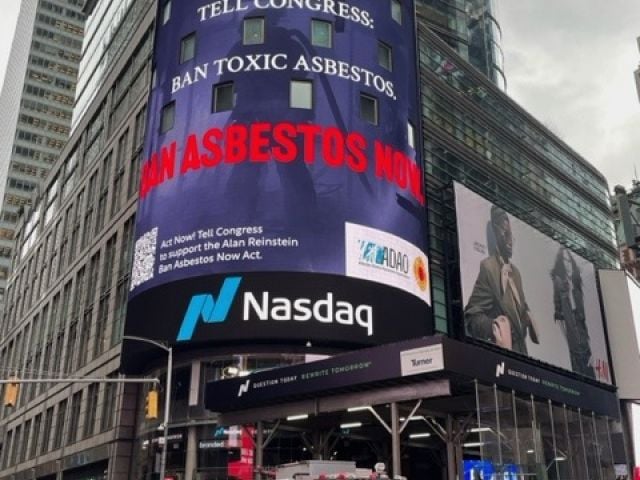May 16, 2007
Ms. Vivian Turner
Designated Federal Officer
Environmental Protection Agency
Via email: [email protected]
Dear Ms. Turner:
Environmental Working Group is disturbed to learn that Dennis C. Paustenbach is on the "Short List" of potential appointees to the Asbestos Panel of the EPA Science Advisory Board. EPA's Invitation for Comments, dated April 19, 2007, specifies that appointees to the Panel should display "absence of financial conflicts of interest" and "absence of an appearance of a lack of impartiality." Based on evidence of his work for defendant corporations in lawsuits over asbestos exposure, his studies that consistently aim to refute or minimize the scientifically established risks of asbestos exposure, and other evidence detailed below of a lack of adherence to scientific and professional ethics, it is clear that Dr. Paustenbach is unfit to serve on the Panel.
Dr. Paustenbach has spent virtually his entire career as a paid expert for polluting corporations arguing for weaker health protections for workers and the public from some of the most notorious toxic substances ever known. To our knowledge, Dr. Paustenbach has never argued for greater health protections from any toxic material, regardless of the science base. To the contrary, Dr. Paustenbach has engineered the fabrication of science to absolve a client of major financial liability, in the case of chromium, a fact that contributed to an article produced by Paustenbach's company being retracted from the Journal of Occupational and Environmental Medicine (JOEM). Paustenbach is legendary in New Jersey where his science, which is now largely discredited, led the state to weaken soil contamination standards for chromium more than a thousand-fold. Now Paustenbach is defending the asbestos industry, leading a science-for-hire campaign to roll back protections from chrysotile asbestos. As we argue below, asbestos is nothing more than a profit center for Paustenbach. It is absurd to think that he will bring any sort of objectivity to the scientific review process on chrysotile carcinogenicity. He has an overwhelming financial interest in only one outcome of this chrysotile review, that which will benefit his clients in the asbestos industry, and is without question unfit to serve on the Panel.
1. CONFLICTS OF INTEREST
Dr. Paustenbach is founder and president of ChemRisk, Inc. As head of this firm, and in previous positions, he has a long history of work for corporations who were defendants in lawsuits over asbestos exposure. His resume on ChemRisk's web site[1] does not disclose the names of his clients. Last year, in an investigation of auto industry lobbying against federal rules on asbestos brakes, the Baltimore Sun cited documents showing that Chemrisk and Paustenbach's previous firm, Exponent, were paid more than $23 million since 2001 by Ford, General Motors and Daimler-Chrysler to help fight asbestos lawsuits brought against them by former workers.[2]
In addition, research by the independent Center for Science in the Public Interest[3] has documented the following list of other Paustenbach clients who are or have been defendants in asbestos litigation, or who are associated with such defendants:
Alcoa
Allied Signal
Amoco
ARCO
Beazer Corporation
Chemical Manufacturers Association
Chevron Chemical Company
Dow Chemical
Exxon
FMC
GATX
General Dynamics
General Electric
Gould Industries
Hercules
ICI Americas
Industrial Health Foundation
Koppers
Maxus Energy Corporation
McKesson
Mobil Oil Corporation
Monsanto
Montrose
Rhône Poulenc
Shell
Stauffer Chemicals
Union Carbide
Vulcan Chemicals
Zeneca
2. LACK OF IMPARTIALITY
According to his resume, in 2005 and again in 2006 Dr. Paustenbach was a featured speaker at conferences organized by the Chrysotile Institute and the International Chrysotile Association, formerly the Asbestos Institute and the International Asbestos Association. These are front groups for the asbestos industry. Numerous articles on the Institute's website make clear that these organizations have a strong bias against the objective evaluation of chrysotile's health hazards:
"If people preaching the banishment [of chrysotile] were really well informed and were using their contacts with the media, in particular, to make public the good and true news about chrysotile, people would not panic any more. On the contrary, they would be reassured of knowing that many cities of the planet were built, irrigated and supplied out of drinking water thanks to chrysotile products, and this, in full safety. Unfortunately, the poor combat they carry out only propagates quite inaccurate information serving only their economic or ideological interests.[4]"
At the 2006 International Conference on Chryosotile in Montreal, Dr. Paustenbach delivered a presentation entitled "The Roles of Dose Reconstruction and Simulation Studies in Understanding Historical Exposure to Asbestos." The 30-minute presentation, available in a video file on the Chrysotile Institute's website,[5] is a thinly veiled pitch for asbestos litigants to hire ChemRisk to conduct simulation studies for their defense. Dr. Paustenbach advises his audience that asbestos juries expect to see such studies, and that the studies asbestos defendants relied on just a few years ago are outdated. Also telling is Dr. Paustenbach's use of the pronoun "we" to refer to the U.S. asbestos industry's response to Congress' proposed creation of a trust fund to cover claims:
"It's a complex subject, and it takes a lot of work and a lot of money to do them [studies]. But I can assure you it's worth the effort. To the best of my knowledge in litigation that was traditionally lost in the United States, I'm not aware of a single case that has been lost when a high quality simulation study was done and exposures were considered de minimus.
. . .
"It's a shame to have to have spent, let's say, $250,000 to do this study when it's really intuitive that there wouldn't be much exposure. But when it costs $4 million in the United States to work up and take a case to trial — that's just the expenses, that's not the outcome — a $250,000 or $500,000 study is a drop in the bucket. So when you heard yesterday — remember we turned down a settlement of $150 billion, that's with a B, to settle the litigation crisis in the United States — these kinds of $250,000, $500,000 investments go a long way. If you've got 100 cases and it takes $4 million for the lawyers and consultants to get ready for the case and to take it to trial, you can see it's a drop in the bucket. So when I hear people say, ÔWe can't afford it,' I don't understand."
3. LACK OF ADHERENCE TO ETHICAL STANDARDS
In July 2006, the prestigious Journal of Occupational and Environmental Medicine (JOEM) retracted a 1997 study that had appeared to be written solely by two Chinese scientists, JianDong Zhang and ShuKun Li. In reality, the paper was largely written by Dr. Paustenbach's firm, ChemRisk, while under contract with Pacific Gas & Electric (PG&E). The retraction was specifically for hiding PG&E's financial sponsorship of the paper as well as ChemRisk's intellectual input, but there is compelling evidence of wider fraud.
Dr. Paustenbach was CEO of ChemRisk when PG&E hired the company to help defend against a major lawsuit brought by the small town of Hinkley, California. Local residents had sued PG&E, claiming that the utility was responsible for contaminating the town's drinking water with hexavalent chromium which, in turn, had caused many serious health problems in the community, including cancer.
Zhang and Li's original paper, published in 1987 by JOEM, had found a strong association between consumption of chromium-6 laced water and stomach, and PG&E wanted to cast doubt on that finding. In 1986, under Dr. Paustenbach's direction, ChemRisk scientists obtained Zhang and Li's original data, manipulated it to obscure the connection between chromium-6 in drinking water and cancer and rewrote their paper. Then they submitted it under Zhang's byline to JOEM, where it was published. JOEM knew nothing of the paper's real author and funding source until Environmental Working Group exposed the deception last year.
Not long after publication of the 1997 paper, PG&E paid damages of $333 million to settle the Hinkley case, which became the basis for the film Erin Brockovich. But the fraudulent study had a much wider impact, influencing a federal Agency for Toxic Substances & Disease Control guidance document and forcing California regulators to re-evaluate a risk assessment for chromium-6 in drinking water, causing several years' delay in setting safety standards.
The details of this fraud are well documented in a front-page article in The Wall Street Journal[6] and in our own investigation[7], which includes links to the original documents making the case against Dr. Paustenbach and ChemRisk. They show convincingly that in the chromium-6 case, Dr. Paustenbach violated the code of ethics of the Society of Toxicology, his professional association, by failing to conduct himself with integrity, failing to be honest and truthful in reporting and communicating his research, hiding clear material conflicts of interest, and failing to avoid situations that imply a conflict of interest.
The task before the Asbestos Panel — to provide technical advice on EPA's proposed methodology to estimate potential cancer risk from inhalation exposure to asbestos — is crucial. EPA's determination will affect the future health and safety of every American who is exposed to asbestos in the workplace and in consumer products. To ensure that this decision relies on the best objective science, without influence of corporations with a financial stake in the outcome, the Asbestos Panel must be free of all conflict of interest or bias, and consist of scientists who adhere to the highest ethical standards. We believe that Dennis C. Paustenbach does not meet those tests.
Thank you. If you need any more information, please let me know.
Sincerely,
Richard Wiles
Executive Director
[1] http://www.chemrisk.com/team/paustenbach.htm
[2] Andrew Schneider, "Pressure at OSHA to Alter Warning," The Sun (Baltimore, Md.), Nov. 20, 2006.
[3] http://www.cspinet.org/integrity/index.html
[4] http://www.chrysotile.com/en/chrysotile/controversy/default.aspx
[5] http://www.chrysotile.com/en/conferences/speakers/Dennis_Paustenbach.aspx
[6] Peter Waldman, "Study Tied Pollutant to Cancer, Then Consultants Got Hold of It." The Wall Street Journal, Dec. 23, 2005.
[7] https://www.ewg.org/reports/chromium



